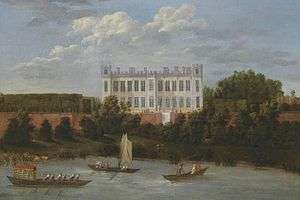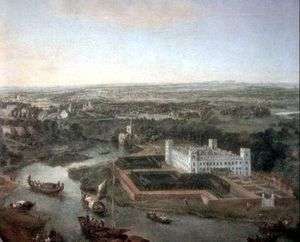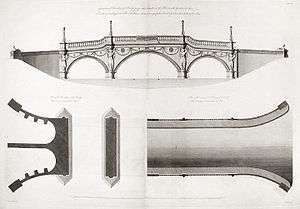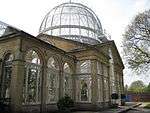Syon House
| Syon House | |
|---|---|
|
West Aspect of Syon House c.2010 | |
 location within Greater London | |
| General information | |
| Location |
Syon Park, London, United Kingdom |
| Country | United Kingdom |
| Owner | Duke of Northumberland |
| Website | |
| Official Website | |
Syon House, and its 200-acre (80 hectare) park, Syon Park, is in west London, historically within the parish of Isleworth, in the county of Middlesex. It belongs to the Duke of Northumberland and is now his family's London residence. The family's traditional central London residence had been Northumberland House, now demolished. The eclectic interior of Syon House was designed by the architect Robert Adam in the 1760s.[1]
History


Syon House derives its name from Syon Abbey, a medieval monastery of the Bridgettine Order, founded in 1415 on a nearby site by King Henry V. The Abbey moved to the site now occupied by Syon House in 1431. It was one of the wealthiest nunneries in the country and a local legend recalls that the monks of Sheen had a Ley tunnel running to the nunnery at Syon.[2] In 1539, the abbey was closed by royal agents during the Dissolution of the Monasteries and the monastic community was expelled.[3]
In 1541 and part of the following year, Henry VIII's fifth wife, Catherine Howard, was brought to Syon for her long imprisonment. In February 1542, she was taken to the Tower of London and executed on charges of adultery. Five years later when King Henry VIII died, his coffin was brought to Syon on its way to be buried in Windsor.
After the closure of the abbey, Syon became the property of the Crown for a short time before coming into the possession of the 1st Duke of Somerset. He then had Syon built in the Italian Renaissance style before his death in 1552. In 1557 it was proposed to return it to its original purpose as an abbey, but this idea was short lived. Syon was acquired in 1594 by Henry Percy, 9th Earl of Northumberland (1564-1632), and has remained in his family ever since.[4]
In the late 17th century, Syon was in the possession of Charles Seymour, 6th Duke of Somerset, through his wife, Elizabeth Seymour (née Percy). After the future Queen Anne had a disagreement with her sister, Mary II (wife of William III, also known as William of Orange), over her friendship with Sarah Churchill, Countess of Marlborough, she was evicted from her court residence at the Palace of Whitehall and stayed at Syon with her close friends, the Somersets, in 1692. Anne gave birth to a stillborn child there. Shortly after the birth, Mary came to visit her, again demanding that Anne dismiss the Countess of Marlborough and stormed out again when Anne flatly refused.
In the 18th century, Hugh Percy, 1st Duke of Northumberland, commissioned architect and interior designer Robert Adam and landscape designer Lancelot "Capability" Brown to redesign the house and estate. Work began on the interior reconstruction project in 1762. Five large rooms on the west, south and east sides of the House, were completed before work ceased in 1769. A central rotunda, which Adam had intended for the interior courtyard space, was not implemented, due to cost.[5]
In 1951 the Syon house was opened to the public for the first time under the 10th Duke and Duchess. Later, in 1995 under the 12th Duke, the family rooms became open to the public as well. As the Percy family continues to live there, they continue to enhance the house. Most recently the Duchess added a new central courtyard with the design of Marchioness of Salisbury.[6]
A £600K restoration was undertaken in late 2007, primarily involving work to the roof area.[7][8] In 2008 restoration work commenced on the Great Hall and a current long-term project is to restore the Adam Rooms.[9]
Architecture


Syon House's exterior was erected in 1547 while under the ownership of the 1st Duke of Somerset. Syon's current interior was designed by Robert Adam in 1762 under the commission of the 1st Duke and Duchess of Northumberland.
The well known "Adam style" is said to have begun with Syon House. It was commissioned to be built in the Neo-classical style, which was fulfilled, but Adam's eclectic style doesn't end there . Syon is filled with multiple styles and inspirations including a huge influence of Roman antiquity, highly visible Romantic, Picturesque, Baroque and Mannerist styles and a dash of Gothic. There is also evidence in his decorative motifs of his influence by Pompeii that he received while studying in Italy.[1] Adam's plan of Syon House included a complete set of rooms on the main floor, a domed rotunda with a circular inner colonnade meant for the main courtyard('meant for' meaning that this rotunda was not built due to a lack of funds), five main rooms on the west, east and south side of the building, a pillared ante-room famous for its colour,[10] a Great Hall, a grand staircase(though not built as grand as originally designed) and a Long Gallery stretching 136 feet long. Adam's most famous addition is the suite of state rooms and as such they remain exactly as they were built.
More specific to the interior of Adam's rooms is where the elaborate detail and colour shines through. Adam added detailed marble chimneypieces, shuttering doors and doorways in the Drawing Room, along with fluted columns with Corinthian capitals. The long gallery, which is about 14 feet high and 14 feet wide, contains many recesses and niches into the thick wall for books along with rich and light decoration and stucco-covered walls and ceiling. At the end of the gallery is a closet with a domed circle supported by eight columns; halfway through the columns is a doorway imitating a niche.[6]
In the 1820s the north range of the house that was not completed by Adam was reshaped by the 3rd Duke. At this time the house was also refaced in Bath stone and the porch rebuilt. This remodelling is thought to have been done by the architect Thomas Cady, who had worked on previous estates belonging to the Percy family.[6]
The Syon House was refurbished again in the 1860s. The 4th Duke had Renaissance-style plaster ceilings put into the Family Drawing Room, Family Dining Room and Print Room.[4]
The final plan of Syon House includes an entrance hall, ante-room, State Dining Room, State Drawing Room, Long Gallery, study, sitting room, Print Room, Family Drawing Room, Family Dining Room, private apartments on the top floor for the family to live in and a grand staircase.[6]
Syon Park
Syon Park borders the Thames, looking across the river to Kew Gardens and near its banks is a tidal meadow flooded twice a day by the river. It contains more than 200 species of rare trees. Although the park and lake were designed by Capability Brown in 1760, their character today is nineteenth century. The circular pool has a copy of Giambologna's Mercury. The park and the house in the background were painted from across the Thames by J. M. W. Turner c.1802-10 in the painting Zion House, Isleworth and in two capriccios in 1805.[11][12]
The Great Conservatory in the gardens, designed by Charles Fowler in 1820's [13] and completed in 1827, was the first conservatory to be built from metal and glass on a large scale. The conservatory appeared (as Heaven) in the original 1967 Dudley Moore-Peter Cook version of Bedazzled, having already featured prominently in John Boorman's first feature film Catch Us If You Can (film) (1965, ostensibly a vehicle for the Dave Clark Five), was shown in a dream sequence in Meera Syal's 1993 film Bhaji on the Beach and was also the setting for the music video to The Cure's 1984 single "The Caterpillar", directed by Tim Pope.
Henry Percy, 11th Duke of Northumberland, who was head of the family from 1988 to 1995, was noted for planting many trees in the grounds of Syon.
In 2002, the English poet Geoffrey Hill released a booklength poem, "The Orchards of Syon", to much acclaim. "The Orchards of Syon", focuses on the history of the region and in particular on the orchard of rare trees first planted in Syon Abbey.
The London Butterfly House was based in the grounds of Syon Park from 1981 until its closure on 28 October 2007 due to the Duke of Northumberland's plans to build a hotel complex on the land. In 2004, planning permission was granted for the deluxe £35-million Radisson Edwardian Hotel. In 2011, the Syon Park Waldorf Astoria hotel opened on the site. The hotel was renamed to the Hilton London Syon Park in 2013.[14][15][16]
Also based in the grounds of Syon Park was the Heritage Motor Museum, a collection of vintage automobiles, which was also founded in 1981. Owing to a major increase in the number of vehicles acquired, in 1993 the museum closed and its collection was transferred to the Heritage Motor Centre at Gaydon in Warwickshire.[17]
In 2002 an annual archaeological dig was initiated originally by the Channel 4 television Time Team programme, to excavate the remains of the lost abbey, the annual dig is now undertaken by Birkbeck College part of the University of London The annual dig is back up by a permanent exhibition in the undercroft[9] In November 2010, the results from an archaeological dig made two years before on the site of the new hotel were reported, with the excavations uncovering the remains of a Roman village that existed in what was then the rural outskirts of Londinium. Artefacts uncovered included 11,500 pottery fragments, 100 coins and pieces of jewellery. Some of the finds remain unexplained, such as the discovery of skeletons "buried in ditches placed on their side". Although the skeletons date from the Roman period, this burial practice was said by the senior archaeologist to be "more suggestive of unknown prehistoric rites than Roman practice".[18]
Syon Park is a Site of Special Scientific Interest.[19][20]
In Media
Despite being on the usually noisy final approach for London Heathrow Airport, the historic house and garden are a popular filming location particularly for historical dramas, including:[21]
Gallery
- East Aspect of Syon House (c.2010).
 A design for the hall by Robert and James Adam.
A design for the hall by Robert and James Adam. Robert Adam's plan for the reconstruction of Syon House.
Robert Adam's plan for the reconstruction of Syon House.- Syon House Great Conservatory.
 Side view of the conservatory.
Side view of the conservatory. Syon Park Enchanted Woodland.
Syon Park Enchanted Woodland.
See also
- Alnwick Castle, the principal seat of the Dukes of Northumberland
- Northumberland House, the former central London residence of the Dukes of Northumberland
- List of Sites of Special Scientific Interest in Greater London
- Hounslow parks and open spaces
References
- 1 2 O'Connor, Imelda (1987). Wit in The Critic and Syon House. Athens, Ohio: Ohio University. pp. 183–218.
- ↑ Westwood, Jennifer (1985), Albion. A Guide to Legendary Britain. Pub. Grafton Books, London. ISBN 0-246-11789-3. P. 126.
- ↑ "Syon Park:History". Syon Park:The London Home of the Duke of Northumberland.
- 1 2 Holmes, Nancy (1991). "Noble House: Three Generations of Percys Enjoy Robert Adam's Neoclassical Grandeur". House and Garden. 163 (4): 181–208.
- ↑ Field, D. M. The World's Greatest Architecture Past & Present. p. 207.
- 1 2 3 4 Musson, Jeremy (2 November 2000). "Syon House, Middlesex: A Seat of the Duke of Northumberland". Country Life: 94–99.
- ↑ "Historic Property Restoration Ltd". Hprltd.co.uk. Archived from the original on 25 April 2012. Retrieved 21 October 2011.
- ↑ "Historic Syon House open again after major works (From Richmond and Twickenham Times)". Richmondandtwickenhamtimes.co.uk. 13 April 2008. Archived from the original on 4 April 2012. Retrieved 21 October 2011.
- 1 2 Syon Park House & Gardens leaflet (2011)
- ↑ "Syon House". Country Life: 795. 21 May 1927.
- ↑ Tate Gallery Turner: Zion House, Isleworth Work reference: D08269 Turner bequest CXXI M. Retrieved 13 July 2013
- ↑ Tate Gallery Turner: Capriccio of the Thames at Isleworth, with the Pavilion at Syon
Tate Gallery Turner: Capriccio of the Thames at Isleworth, with the Pavilion at Syon Work references: D0619(7/8) Turner bequests XCVIII (13/14). Retrieved 2013-07-13 - ↑ "Great Conservatory". Syon Park. Retrieved 18 July 2008.
- ↑ Brown, Ed; McGrath, Martin; Davis, Matt. "So Crosse As Butterflies Head North". News Associates. Retrieved 18 July 2008.
- ↑ Malvern, Jack (5 January 2005). "Duke's hotel is a threat to butterflies' historic home". The Times. Retrieved 18 July 2008.
- ↑ Smith, Graham (20 May 2013). "London Syon Park no longer a Waldorf Astoria hotel". Business Traveller. Panacea Publishing. Retrieved 10 August 2016.
- ↑ "About the Heritage Motor Centre". Heritage Motor Centre. Retrieved 12 July 2014.
- ↑ Entire Roman village is unearthed in Syon Park, Louise Jury, Chief Arts Correspondent, Evening Standard, 16 November 2010
- ↑ Natural England citation, Syon Park
- ↑ "Map of Syon Park SSSI". Natural England.
- ↑ London History Tours; Adrian Sill; Jeremy Tipton. "Syon House & Gosford Park". shadyoldlady.com.
- ↑ "Gosford Park". The Castles and Manor Houses of Cinema's Greatest Period Films. Architectural Digest. January 2013. Retrieved 2 January 2013.
- ↑ "Emma 2 - Miramax Emma - Gwyneth Paltrow :: Emma Adaptations Pages :: Jane Austen's Emma :: Emma Jane Austen Emma Movie Emma". strangegirl.com.
- ↑ "The Avengers film locations". The Worldwide Guide to Movie Locations.
Sources
- Field, D. M. (2007). "Syon House". The World's Greatest Architecture Past & Present. New Jersey: Chartwell Books.
- "Syon Park". Hidden London. Chambers. Retrieved 16 September 2008.
- "Syon Park:History". Syon Park:The London Home of the Duke of Northumberland. 2004. Retrieved 14 September 2008.
Further reading
- Syon House; The Story of a Great House – With a short guide for visitors and with 4 (colour) plates, 2 endpaper maps (in colour) and 22 illustrations in Monochrome (The illustrations mainly relate to paintings, artefacts and the building). First published by Syon House Estate (UK) in 1950 with 48 pages and no ISBN.
External links
| Wikimedia Commons has media related to Syon House. |
- Syon Park official site
- Syon House entry from The DiCamillo Companion to British & Irish Country Houses
- Syon House on Images of England website with architectural details
- Aerial photo and map
- Drawings and photos
- A detailed historical record of Syon House

